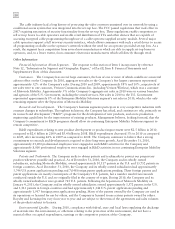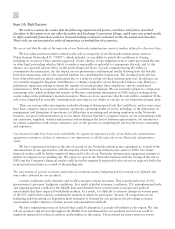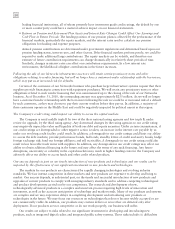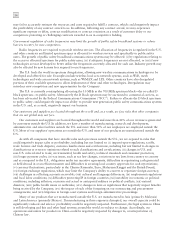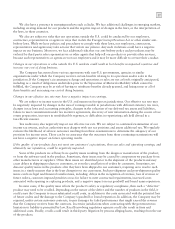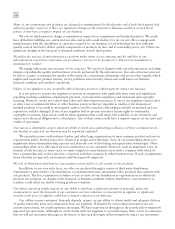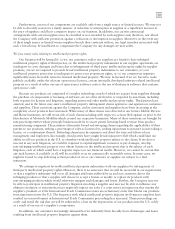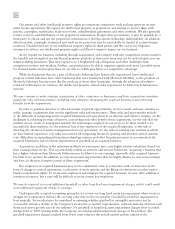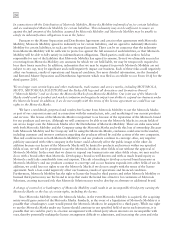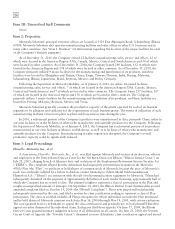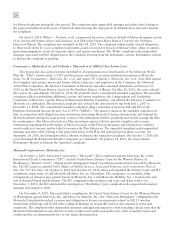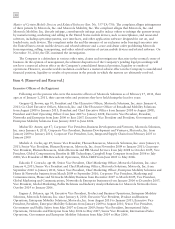Motorola 2010 Annual Report Download - page 28
Download and view the complete annual report
Please find page 28 of the 2010 Motorola annual report below. You can navigate through the pages in the report by either clicking on the pages listed below, or by using the keyword search tool below to find specific information within the annual report.
20
Our patent and other intellectual property rights are important competitive tools and may generate income
under license agreements. We regard our intellectual property as proprietary and attempt to protect them with
patents, copyrights, trademarks, trade secret laws, confidentiality agreements and other methods. We also generally
restrict access to and distribution of our proprietary information. Despite these precautions, it may be possible for a
third party to obtain and use our proprietary information or develop similar technology independently. In addition,
effective patent, copyright, trademark and trade secret protection may be unavailable or limited in certain foreign
countries. Unauthorized use of our intellectual property rights by third parties and the cost of any litigation
necessary to enforce our intellectual property rights could have a negative impact on our business.
As we expand our business, including through acquisitions, and compete with new competitors in new markets,
the breadth and strength of our intellectual property portfolio in those new areas may not be as developed as in our
longer-standing businesses. This may expose us to a heightened risk of litigation and other challenges from
competitors in these new markets. Further, competitors may be able to negotiate significantly more favorable terms
for licensed intellectual property than we are able to, which puts them at a competitive advantage.
While the businesses that are a part of Motorola Solutions have historically experienced lower intellectual
property-related risks than have other businesses that were transferred with Motorola Mobility, as the products of
Motorola Solutions become more like the products of those other businesses, through the adoption of industry-
standard technologies, for instance, the intellectual property-related risks experienced by Motorola Solutions may
increase.
We may continue to make strategic acquisitions of other companies or businesses and these acquisitions introduce
significant risks and uncertainties, including risks related to integrating the acquired businesses and achieving
benefits from the acquisitions.
In order to position ourselves to take advantage of growth opportunities, we have made, and may continue to
make, strategic acquisitions that involve significant risks and uncertainties. These risks and uncertainties include:
(i) the difficulty in integrating newly-acquired businesses and operations in an efficient and effective manner; (ii) the
challenges in achieving strategic objectives, cost savings and other benefits from acquisitions; (iii) the risk that our
markets do not evolve as anticipated and that the technologies acquired do not prove to be those needed to be
successful in those markets; (iv) the potential loss of key employees of the acquired businesses; (v) the risk of
diverting the attention of senior management from our operations; (vi) the risks of entering new markets in which
we have limited experience; (vii) risks associated with integrating financial reporting and internal control systems;
(viii) difficulties in expanding information technology systems and other business processes to accommodate the
acquired businesses; and (ix) future impairments of goodwill of an acquired business.
Acquisition candidates in the industries in which we participate may carry higher relative valuations (based on
their earnings) than we do. This is particularly evident in software and services businesses. Acquiring a business that
has a higher valuation than Motorola Solutions may be dilutive to our earnings, especially if the acquired business
has little or no revenue. In addition, we may not pursue opportunities that are highly dilutive to near-term earnings
and have, in the past, foregone certain of these acquisitions.
Key employees of acquired businesses may receive substantial value in connection with a transaction in the
form of change-in-control agreements, acceleration of stock options and the lifting of restrictions on other equity-
based compensation rights. To retain such employees and integrate the acquired business, we may offer additional
retention incentives, but it may still be difficult to retain certain key employees.
We may be required to record additional goodwill or other long-lived asset impairment charges, which could result
in an additional significant charge to earnings.
Under generally accepted accounting principles, we review our long-lived assets for impairment when events or
changes in circumstances indicate the carrying value may not be recoverable. Goodwill is tested for impairment at
least annually. Factors that may be considered in assessing whether goodwill or intangible assets may not be
recoverable include a decline in the Company’s stock price or market capitalization, reduced estimates of future cash
flows and slower growth rates in our industry. No goodwill or long-lived assets impairment charges were recorded
during 2010 or 2009. During 2008, the Company recorded goodwill impairment charges of $1.6 billion. The
goodwill impairment charges resulted from lower asset values in the overall market and the impact of the


